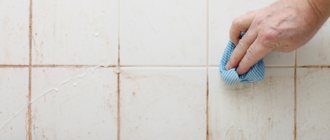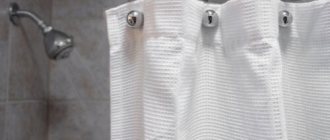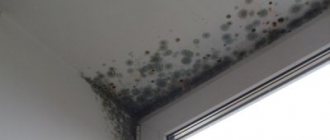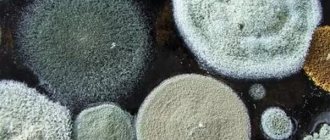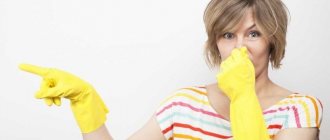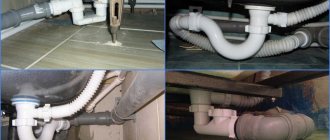High indoor humidity and hot steam, which increases the air temperature, are the main factors affecting the microclimate. If ventilation is impaired or not provided, the process of reproduction of pathogenic particles, including fungal spores, is activated. When choosing a way to get rid of mold in the bathroom, consider home remedies because they are gentle on walls and floors. If traditional methods do not help, deep penetration chemicals are used.
Hot steam affects the microclimate of the room.
Common Types of Mold
This is the name given to filamentous formations that form a single multicellular structure. Mold multiplies quickly, the main manifestations being stains on surfaces. Plaque of organic origin can have a different shade. The most dangerous types of mold:
Chaetomium globosum causes damage to wallpaper, window frames, books, and so on.
- Chaetomium globosum, or biodestructor. Found on coatings and things containing cellulose. Mold affects wallpaper, drywall, window frames, books, paintings, etc. At the initial stage, the fibers are characterized by a white color. Gradually the shade changes to olive with a gray undertone or black. This type of mold is most dangerous for people prone to developing allergies. Provokes the appearance of symptoms of asthma, rhinitis, and respiratory diseases.
- Cladosporium herbarum. Promotes the development of negative reactions in allergy sufferers and people not exposed to pathogenic particles. This type of mold is not always black in color. Colonies may be olive or brown in color. This is a type of mold that destroys various objects. It is found on any things, lining, etc. Other types of mold in this group: Chaetomium, Ulocladium, Aspergillus, etc.
- Blue fungus. Modifies surfaces - they acquire a characteristic color. The fungus develops in conditions of high humidity and affects objects made of coniferous wood. It can be found in private houses, rarely in an apartment.
Chemicals against fungus on ceramics in the bathroom
Getting rid of fungus on tiles is facilitated not only by the above remedies, which any caring housewife always has on hand. This can also be done through specialized drugs intended for these purposes.
Treatment with such preparations allows you to completely clean all surfaces in the room, including areas under sanitary and hygienic devices. However, the main task is to eliminate the causes of mold growth.
Before embarking on cleaning activities, you must study and strictly adhere to the rules for pre-treatment of surfaces. First, severe contamination is removed, then the area is dried using a hair dryer. It is not recommended to include water during the treatment procedure, because the air regime must be kept dry. The seams between the tile elements are also thoroughly treated with antifungal agents.
Please note: when working on surface treatment with special chemicals, always follow personal safety rules. The face is covered with a protective mask, hands with rubber gloves. This is the only way to avoid harm from the use of active chemical compounds, contact with which in a closed space can hardly be avoided.
A solution of copper sulfate is used to remove mold in the toilet and bathroom directly from the tiles and from the seams. The toxicity of vitriol should be a warning to take safety precautions. The instructions for use state that the product is mixed with water in a ratio of 100 to 10, that is, 100 g of the substance is added to 10 liters of water. The tiled surface is treated with a solution in which a sponge is soaked. Vitriol is applied to the seams with a toothbrush or brush. In places where there is a strong accumulation of blackness, the product is passed over repeatedly. Then wait several hours and wash the base. The air in the room is ventilated.
Chlorine bleach is also an excellent mold remover. The substance does not require rinsing. After the procedure, the space is ventilated.
List of industrially produced anti-mold preparations:
- Renogal;
- PS 50;
- Titan Fungcide;
- impregnation "Snowball";
- Spectrum.
Many people neglect to purchase these specialized antifungal drugs, preferring more budget-friendly options (for example, copper sulfate). However, excessive enthusiasm for the latter can be costly for the homeowner. Since the use of copper sulfate, getting rid of one type of fungus, can cause the development of another. In this connection, the most preferable option is to choose a modern industrial product.
You can eliminate mold on bathroom tiles by treating it with furatsilin. This remedy has proven itself on the positive side in the fight against blackness. Why apply furatsilin solution - 1 tablet per liter of water. Moreover, the drug is inexpensive and quite effective. Many who used it claimed that they forgot for a long time what a fungal infection on the walls was.
Please note: it is possible to spray an antiseptic only when there are no children, adult relatives or pets living in the house. When mold appears in sanitary facilities, it is important not only to take measures to eliminate it, but to minimize all further possibilities for its appearance. A fairly common cause of a humid climate in the bathroom is pipes covered with condensation, leaking taps, damage to the waterproofing of drains or water pipes and other malfunctions with plumbing fixtures.
Professional products will help solve the problem of blackness on ceramic coatings. Their packaging should clearly state that they kill mold and are not preventatives. The decision about whether to use such means, or whether to use popular advice, must be made by everyone, taking into account the specific situation.
Why is fungus on walls dangerous?
Not all species pose a threat to human health. For example, the fungus Wallemia from the black mold group is difficult to remove, but does not pose a danger. However, most varieties contribute to the development of allergies (at best). With prolonged contact with fungal spores, more severe complications arise: asthma, chronic bronchitis, skin diseases, pneumonia.
Fungus on the walls can cause various skin diseases.
Against the background of intoxication of the body, nausea, abdominal pain appear, and the functioning of the digestive tract and musculoskeletal system is disrupted. With prolonged contact with the most toxic types of fungi (for example, black mold), liver and lung function deteriorates. In the most severe cases, irreversible tissue changes occur and death is possible. The fungus poses a danger to people with reduced immunity: during the period of recovery from illness, while taking antibiotics, while undergoing chemotherapy.
Under the influence of mold, facing materials on walls, floors, and ceilings are destroyed. In this case, the coating is deformed: it swells, peels off, and its structure is disrupted. As a result, it is necessary to re-repair the premises and remove the finishing layer from the affected surfaces and adjacent areas.
If mold is in the bathroom for a long time, then it is more likely that it will penetrate quite deeply into the structure of the structure.
The longer mold has a destructive effect on a building material, the higher the likelihood that it will penetrate into the structure of the supporting structure to a significant depth. However, in most cases, it is possible to remove the fungus at the stage of its active development in the plaster layer. If the surface is not cleared of dark organic stains that have appeared in time, partial or complete destruction of the coating will soon occur.
Methods for cleaning seams
First way . Simple and fast. For it, take regular soda and bleach or vinegar solution. To do this, apply a liquid bleach solution along all the seams between the tiles where there is blackness. Next, wipe the areas previously treated with the solution with a cloth (sponge); the composition should be completely washed off the walls. They consolidate the result by walking over the same places with soda.
Second way . Sodium bicarbonate (ordinary soda) is taken and poured onto a flat dish. Taking a toothbrush, wet the bristles and dip them in soda powder. Next, wipe the gaps between the tiles with a brush and soda. Then the treated seams are rinsed with water and wiped dry.
The first two methods really help get rid of blackness. Six months is how long their shelf life may be. Therefore, repeated fungal infection of tiled surfaces in the bathroom is possible. Anyone who does not intend to experiment for too long with different methods can choose more effective measures.
Third way . Instrumental, involving the use of a hand tool - a screwdriver. Taking it in hand, they try to remove the entire layer of grout from the seams. Yes, the procedure is not easy. However, it is also the most effective, allowing you to eliminate mold on grout without dismantling the tiles. Mechanically, with a little effort, it is possible to remove both mold and its source. The method is dangerous. In addition, damage can be caused to the tiles. After opening the cracks, they are treated with vinegar, and after that they are covered again with a sealing fugue. In this case, the grout must be selected that contains both moisture-repellent and antiseptic substances.
Mechanical method of removing fungus
One of the tools you will need to remove fungus mechanically is a spatula.
When black spots appear on the sealant in the joints between tiles in the bathroom or on the walls in living areas, the affected coating must first be removed. Different tools are used for this:
- putty knife;
- steel brush;
- grinding attachment (installed on the drill);
- sharp knife, etc.
To prevent the spread of spores through the air (the main method of contamination of surfaces), the cladding must be treated with water. To do this, it is recommended to use a spray bottle. If you use a sponge or rag, some of the spores will become airborne when the material comes into contact with the surface. When the fungus has already penetrated the structure of wood or concrete, the milling method is used. When the infection is severe, mold is also found on inorganic surfaces. If you plan to fight it yourself, it is important to follow the instructions:
- The surface is moistened with water from a spray bottle.
- They free load-bearing structures from cladding: wallpaper on the walls, whitewash on the ceiling, flooring. This will allow you to get to the mycelium.
- If it turns out that the mold has penetrated deeper into the structure of the material of the supporting structure, remove the layer of plaster. It is necessary to clean the wall down to the rough base - brickwork, concrete.
At the next stage, chemicals are used. However, if the preparatory work (mechanical cleaning) did not provide the required result, special means will not destroy the fungus. It will continue to develop on the adjacent site.
Chemical agents can also be used against fungus.
How to get rid of mold smell
The unpleasant musty smell will go away on its own if you manage to get rid of mold in the bathroom. This will be facilitated by regular ventilation of the room, an open pack of soda or a glass of iodine solution (1 tsp per 200 ml of water) standing on the shelf.
Soda has the ability to absorb odors well, but if you put it in the bathroom for this purpose, then do not use it in cooking.
So that you don’t have to deal with how to get rid of mold in the bathroom, take note of the following recommendations:
- Do not keep the bathroom door tightly closed at all times;
- after taking water procedures, ventilate the room using natural or forced ventilation;
- wipe dry any remaining condensation that has settled on the surfaces of mirrors and tiles;
- do not use the bathroom for drying clothes;
- repair leaking taps and plumbing fixtures in a timely manner;
- do not forget to monitor the condition of shelves, soap dishes and glasses for toothbrushes.
We hope that our tips will help you get rid of mold in your bathroom or shower.
Folk remedies against mold
Before the advent of special preparations, home methods were used to remove dark spots from surfaces. Some of them remove mold well, which is why they are still used today. However, in terms of effectiveness, they do not always correspond to ready-made drugs. This is partly due to the fact that they use products that have a simple composition (contain 1 component).
To achieve the required result, in most cases it is recommended to apply the substances several times: from 2 to 5. A single treatment does not help destroy pathogenic particles.
Hydrogen peroxide
Hydrogen peroxide against fungus in the bathroom.
A 3% solution is used, it can be purchased at a pharmacy. The advantages of this tool:
- ease of use;
- no odor;
- the substance leaves no traces;
- peroxide can be applied to coatings made of different materials; it does not destroy their structure, but a weak bleaching effect appears on colored surfaces.
To clean mold, you do not need to dilute the substance with water. Instructions for use:
- The product is applied to the surface where the fungus develops. Moreover, the area of this zone should be larger than the affected area.
- We need to vacate the premises for a few hours. If the lesion is weak, 15-60 minutes is enough. During this period of time the premises cannot be used.
- After a few hours, you can ventilate the room, then remove the mold using a stiff brush.
Boric acid
To clean fungus from surfaces at home, prepare a solution: 1 cup of the drug, 2 liters of water. In this case, it is recommended to first remove external manifestations of mold. The surface is first moistened with water to prevent spores from spreading through the air. Once the dark spots have been removed, a boric acid solution can be applied. To do this, use a rag or a soft sponge.
Using boric acid against fungus in the bathroom.
The product is left on the surface. After it dries, the remaining powder and emerging crystals are cleaned off with paper or another sponge. In this case, you cannot use materials that were used to remove the fungus from the surface, because in this case, infection will occur again.
It is permissible to use a less concentrated solution: 4 liters of water, 1 glass of boric acid. It is used to treat surfaces by spraying with a spray bottle. Borax can be used instead of boric acid. These are different substances that exhibit similar properties. Both are antiseptics, but borax is less effective.
Tea tree oil
Tea tree oil for fungus in the bathroom.
This product helps remove fungus, since microorganisms are sensitive to the components that make up it. It is necessary to prepare a solution: 1 tsp. essential oil, 500 ml water. The substance is sprayed over the affected surface, then the dark coating is removed.
The duration of action of the product is 12 hours. Moreover, you cannot be indoors at this time. There is no need to rinse it off after the solution has finished working.
It is necessary to take into account that the aroma will remain in the room for some time. In case of intensive infection, prepare a more concentrated solution: 20 ml of essential oil, 1 liter of water.
Soda and vinegar
You can use soda ash and baking soda. If mold appears on tiles and other surfaces that can withstand exposure to aggressive substances, it is recommended to prepare a solution:
- Heat water (5 l).
- Add 150 g of soda of any kind. Moreover, the desired chemical reaction will occur provided that the components are diluted with hot water.
- Vinegar essence (9% concentration) - 100 g is poured into the resulting solution.
Killing fungus in the bathroom with baking soda and vinegar.
When mixing the components, foam is formed. After obtaining the desired chemical reaction, you can apply the product to the affected surfaces. To destroy fungus that has spread extensively along the wall/ceiling or floor, you need to carry out repairs - this is a radical method, but thanks to it mold is destroyed forever. First, remove the plaster, then sprinkle the area with soda and spray with concentrated vinegar.
Aqueous ammonia
This product can be applied to coatings that are characterized by the absence of pores, for example, to the joints of ceramic tiles in the bathroom. To improve the properties of aqueous ammonia, glycerin is added. Apply the substance using a rag or sponge. Care must be taken when doing this, as aqueous ammonia is toxic. After treatment, you need to leave the room for 1 hour. Then the remaining product is washed off from the surfaces.
Use of aqueous ammonia.
Copper sulfate
This method is considered the most effective in combating fungus. It is distinguished by a significant impact on pathogenic particles. Prepare a solution using 100 g of copper sulfate (copper sulfate), 10 liters of water. If the affected area is small, the number of components is proportionally reduced. Use a brush for application. It is recommended to treat an area ¼ or 1/3 larger than the area where the fungus is developing. After a few hours, ventilate the room, wash off the solution, and along with it the fungus.
The effectiveness of using copper sulfate against fungus.
Chlorine bleach
Any product containing chlorine can be used. To destroy the fungus, Belizna and Domestos are suitable. A concentrated product is applied to the affected areas. A rag is used for this. Cleaning silicone (tile joints) is carried out with an aqueous solution based on a chlorine-containing agent. The ratio of components is 1:1. Use a spray bottle for spraying.
Getting rid of mold using specialized products
In the assortment of specialized stores, it is easy to choose antiseptic compositions aimed at combating fungus in the bathroom:
- The “Antifungal-Anti-Mold” product presented can be used to treat surfaces as a primer during repairs. And they also add it to whitewash or water-based paints. If you are deciding how to remove fungus in the bathroom without dismantling the finish, then you should treat all stains with a brush or roller.
- Antiseptics from the “Isocide” series of the Ukrepservice enterprise allow you to fight mold on various materials, destroying other harmful microorganisms that can be found in the bath.
- It is important to know how to remove fungus in the bathroom using means that are safe for health. For example, latex emulsion “MIL KILL”, produced by. It is often used during repairs as a preventive primer, although if necessary, you can use it to clean any hard-to-reach places where dark spots are noticed.
- Allows you to get rid of black mold in the bathroom with the universal antiseptic “DALI”, offered by JSC NPP Rogneda, sold in finished form.
Many people, faced with the problem of how to destroy fungus, turn to time-tested solutions. An example is copper sulfate (100 g of powder is diluted in 10 liters of water). Apply it to all surfaces, after wearing gloves and a respirator. Then the areas with obvious mold infestation are coated again. After 7–8 hours, the treated surface is washed, dried, and the room is ventilated.
Another well-known composition for removing black mold in the bathroom is chlorine bleach, which is added to water in a ratio of 1:10. When working, you need a respirator and rubber gloves. If you get rid of fungus in this way, then there is no need to wash off the applied product, but the room should be thoroughly ventilated.
Armed with the knowledge of how to remove mold in the bathroom, it is advisable to use the preparation “Renogal” (Germany) to treat the seams, which will preserve the lining. If fungal colonies are removed with a solution of bleach or copper sulfate, then after washing them off, the joints are coated with a sealant.
Before you fight to keep surfaces free from fungus and make a purchase, you need to study information about antiseptics in order to choose the variety that is suitable for your specific conditions.
Household chemicals
Effective drugs are being developed to kill mold. With their help, you can get rid of pathogenic microflora forever. It is important to study tips on the use of potent drugs, which will help prevent the occurrence of health problems.
Cillit Bang Spray
This is a type of chlorine-containing product. The composition includes a significant amount of chlorine, which increases the effectiveness of the spray. After spraying, this product is left on the surface for 20 minutes. Considering that it is highly toxic, you should not stay indoors at this time. After 20 minutes, the substance is washed off.
Cillit Bang anti-mold spray in the bathroom.
Bagi Anti-mold spray
This is a highly specialized drug used in the fight against fungi and mold. Ingredients: hypochloride <5%, urfactants 5-15% - stabilizers, purified water and perfume. It is recommended to use it to process tiles, plastic, cast iron, and acrylic. The product should not be used on untested surfaces. After application, you need to wait a little, then the substance is washed off with water.
Bagi Anti-mold spray is a highly specialized drug.
Dec spray from Neohim
This is an antibacterial agent, with its help it destroys not only fungi, but also other types of microorganisms. The advantage is its universal action. The substance is used to treat almost any coating. After use, you need to wait a while, then wash off the substance with water.
Dec spray from Neohim is an antibacterial agent.
Prosept Bath Fungi
Belongs to the group of alkaline antibacterial agents and contains chlorine. This drug is available in the form of a spray. It is used to treat surfaces against fungus and bacteria. After spraying, you need to close the room for several hours, or better yet, all night. Then the substance is cleaned from the surface along with the remnants of the fungus.
Prosept Bath Fungi containing chlorine.
Mellerud product from Germany
Under this brand, various products are produced that differ in composition: with chlorine, without this component. Regardless of the type, it is recommended to be careful when working with such substances, as they are toxic. The surfaces are treated with the spray and the substance is removed after 20 minutes. Moreover, it is necessary to use a lot of water to wash off the product.
Mellerud product.
Effective prevention measures
To prevent the appearance of black mold in the bathroom on the ceiling, walls, and corners, it is worth taking care of prevention even at the stage of major repairs. Add antiseptics, fungicides, and antifungal primers to finishing compositions. Or cover finished surfaces with them. The best manufacturers of such products are:
- Milkill – for processing concrete, cement, brick;
- Acryl grundierung – a preparation for deep penetration;
- Schimmelstopp dufa – fungicidal additive for grout, concrete;
- Mixonit gr43 is a broad-spectrum product.
If there has been no treatment, you can prevent fungal infection with a few simple measures:
Keep an eye on the humidity
Avoid leaking taps, replace iron pipes with plastic ones, and dry clothes outside the bathroom. An effective solution is the installation of “warm” floors, which allows you to maintain humidity at a level of 30% and below. You can install a heating radiator. For a budget-friendly option, use a fan heater after every bath or shower.
Install good ventilation
If the existing natural exhaust is not enough and condensation appears constantly, install an additional forced ventilation system. A fan mounted on the exhaust grille is usually sufficient.
Important
When choosing an exhaust fan, choose the model with the maximum power. When installing, please note that it should draw air out of the bathroom, and not vice versa.
Keep clean
Frequent sanitation, wiping surfaces dry, and opening the door after swimming will help reduce the risk of mold. Clean plumbing fixtures, pipes, valves, walls and other tiled surfaces every week. If you have a steam cleaner that supplies steam with a temperature above 130 degrees.
Buy a powerful heated towel rail
For a bathroom where there is no “warm” floor, and the heated towel rail is just a piece of pipe with hot water, install a system with a larger surface area. The greater the length and diameter, the better. In this case, even wet towels will not affect the humidity.
Important
Any heat source in the bathroom works well along with proper ventilation. If there is no inflow and outflow of air, then additional heating of moist air will only accelerate the growth of mold.
Other methods
- A more costly, but also the most effective solution may be to use an air dehumidifier or ionizer. Both devices are extremely harmful to mold. The ionizer also destroys other types of pathogenic microflora: viruses, bacteria. An ozonizer can help prevent mold.
- Don't dry things in the bathroom. This also applies to towels. After each bath or shower, hang the towel to dry on the balcony or other warm place. Water evaporation from the surface of any textile is a source of moisture.
- The bathrooms of some apartments and private houses have a small window. It can go out onto the street or into an adjacent room. Usually it is dull. Don't be lazy and replace it with an opening one. This will provide additional ventilation.
At the first signs of damage, you can try to get rid of the fungus by removing the affected layer of finishing, followed by treatment with an antiseptic. If the infection process does progress, one of the effective options for combating black mold is to contact special services.
Employees of sanitary and epidemiological stations are armed with the most modern and safe drugs, powerful equipment and accumulated experience. The result is guaranteed, although it will cost a certain amount.
In this article, we looked at the question of how to get rid of mold in the bathroom at home. We hope our recommendations helped you. Don't forget to share the post with your friends !
Professional methods of fungus destruction
For this purpose, concentrated preparations are used, which are highly effective in combating mold and other pathogenic particles. For comparison, if you use folk remedies, you will need to apply the substance many times. Professional methods allow you to destroy the fungus in 1-2 approaches. Such preparations are produced in the form of concentrated liquids. With their help, a solution is prepared or the substance is applied undiluted.
Sanitation and ionization of the room
The purpose of the measures is to destroy mold. To do this, ionized air is used, it is supplied under high pressure towards the affected surfaces. The advantage of this method is the absence of an unpleasant odor. The product is non-toxic; after treatment there is no need to rinse off the substance.
There is a detrimental effect of silver ions on pathogenic particles: fungus, bacteria, etc. The disadvantage of the method is the need to use special equipment, which is expensive. For this reason, it is necessary to invite specialists to process the housing.
Conclusions and useful video on the topic
The video below shows how to remove fungal colonies in the bathroom:
The fight against mold should be carried out constantly. After eliminating fungus in the bathroom using folk or professional remedies, it is important to follow all recommended preventive measures that will help avoid the appearance of new outbreaks.
Perhaps you know other effective ways to destroy fungus in the bathroom and have you tried them in practice? Please tell our site visitors about them. You can do this by leaving a comment on the article in the block below.
Safety rules when processing premises
When treating a room for mold, a respirator is required for safety reasons.
When carrying out mold removal work, it is necessary to ensure protection of the outer coverings:
- use a respirator to prevent fungal spores from entering the respiratory tract and avoid poisoning by chemical vapors;
- you need to work with gloves;
- If spray is used, safety glasses should be worn.
After finishing the treatment, it is recommended to throw away the used products. The room also needs to be prepared: small items (bottles, hygiene products, etc.) are taken out. Furniture and other large items can be left, but they should be covered with plastic. After application of the product is completed, the room is closed for 1-12 hours. Once the substance has been removed from the surfaces, it is better not to enter the room for several days.
Consequences of infection with pathogenic flora
Most of us don't understand the extent of the widespread problem. Often, housewives simply wipe away black stains from surfaces during routine or general cleaning, giving little thought to the harmful effects of dampness in the bathroom.
Firstly, together with mold, which is a colony of a single-celled fungus, a fungus appears - a more complex system of organisms. Fungal spores can be present everywhere, but they only reproduce in moist environments.
Secondly, the thriving activity of the fungus can cause a number of serious difficulties, the most innocent of which may be a terrible smell from bath accessories.
Here are some consequences of bacterial contamination in the bathroom:
- rapid destruction of building materials. Black or white fungus is capable of corroding any building texture to the ground within 1-2 years. If we don’t take action, we will start doing major repairs every year;
- the spores floating in the air will certainly move to other rooms and, finding damp places, will begin to multiply there too;
- pathogenic flora freely enters the human respiratory tract, causing allergic bronchitis and sinusitis, asthma, severe lung damage that is difficult to diagnose;
- the use of bath accessories contaminated with microbial spores causes thrush, stomatitis, streptoderma, allergic dermatitis, mycoses of the feet and nails;
- Constant inhalation of excretion and metabolic products of bacteria affects the human gastrointestinal tract, causes dysbacteriosis, diarrhea, vomiting, and weakens the immune system.
Before you think about how to remove mold from the bathroom forever, you need to determine the cause of its appearance.
Otherwise, the titanic efforts of the owners will have a temporary effect. After some time, fluffy stains and black stripes between the facing panels on the sealant, to our chagrin, will appear again. Here is a list of common causes of bathroom mold infestation.
- Incorrectly installed ventilation or heating system. A well-heated room and moisture retention are the prerequisites for the breeding of harmful microflora.
- Lack of natural sunlight, as UV rays have a detrimental effect on the life of fungi.
- Poor quality sealing of interpanel seams. If the sealant is damaged, a shift in the “dew point” in the walls due to temperature changes causes condensation, which constantly moistens the surfaces.
- Damaged drainage system. A constantly and imperceptibly leaking faucet or pipe under the bathtub are possible sources of dampness; The fungus cannot be removed until the emergency area has been localized.
- Insufficient cleaning after bath procedures. Evaporation and drops of moisture on the walls, sealant between tile and polymer panels must be thoroughly wiped off after taking a shower.
- Drying used wet towels in the bathroom. The fungus simply loves such epicenters of dampness. Wet laundry should only be dried in fresh air.
How to prevent mold
It is recommended to maintain acceptable indoor conditions: minimize humidity levels and control air temperature. However, mold can develop when all indicators are normal: the temperature is +20°C, the humidity level is 30%. For this reason, in order to avoid the development of fungus, it is necessary to increase the efficiency of the ventilation system - you need to install a fan, which will increase air circulation. While drying clothes and after water procedures, do not close the doors to the bathroom. The same conditions must be met in the kitchen.
Mold prevention
It is quite possible to remove mold and mildew from food with diligence and some time.
It is much more important to prevent their reappearance. To do this, you need to take into account simple advice from experts. Do not leave damp or wet clothes in the bathroom; dry them outside. Provide the room with constant air circulation, maybe even artificially. Finally, fix the emergency plumbing and seal the interpanel seams of the room.
After taking a relaxing bath or extensive laundry, wipe all surfaces dry with antiseptic. Follow these simple tips and your bathroom will always be an oasis of cleanliness and freshness.
Traditional methods
Most folk remedies allow you to get rid of the external manifestations of the fungus for a while. You will remove traces of it from the surface, but its spores will remain in the material. And if so, after some time the spots will appear again. Only a radical solution to the humidity problem can help - effective ventilation. In a dry room, fungus/mold will not be able to develop.
Those who have fungus in the bathroom are ready to use all possible means to get rid of it
Using products that are harmless to humans
Regular vinegar and soda will help get rid of mold in the bathroom. There are several methods for using them:
- Wipe the walls with alcoholic table vinegar, leave for several hours, closing the doors, rinse with water, then ventilate.
- The method for horizontal surfaces is to pour baking soda, add vinegar, wait for the reaction to finish and rinse with water.
- Wipe the walls first with baking soda, then with vinegar, then with water.
It’s difficult to say how effective these mold remedies will be, but vinegar helps remove hardness salts perfectly - the white coating is washed off without a trace.
Baking soda and vinegar - you can try
The next folk remedy for fighting mold in the bathroom is peroxide. They also use it to wipe down walls. But we must remember that peroxide in large quantities is toxic and you need to work with a mask and gloves. Also, do not forget that it has a whitening effect. If you treat the grout in the joints between the tiles, it will become several tones lighter.
Disinfect with hydrogen peroxide
https://youtube.com/watch?v=BOSH9Q33oTI
Hazardous substances
In first place in terms of frequency of use are bleach and chlorine-containing detergents for cleaning plumbing fixtures - Belizna, Domestos, Utenok, etc. They are diluted with a certain amount of water, coated with walls, especially carefully treating the seams between the tiles. External manifestations (dark spots) go away very quickly, literally before our eyes. For some time after treatment, mold does not appear, but sooner or later (usually in the autumn or spring season) it begins to appear again.
When working with bleach and preparations made from it, you must wear gloves, a respirator and protective clothing. After treatment, it is advisable to turn off the ventilation (if there is forced ventilation), close the doors tightly, and not use the bathroom for some time. Chlorine does not remain in a free state for long, but at this time it is very active, including its vapors. This “gas” chamber will allow you to disinfect corners that cannot be reached with a brush.
You have to be careful with bleach and copper sulfate
The next most popular way to get rid of mold in the bathroom is treatment with a solution of copper sulfate. Take 100 grams of powder, dissolve it in 10 liters of water and treat the walls and ceiling with this solution
The precautions are the same as when using bleach. The results, in principle, are not very different either - temporary relief from black marks.
https://youtube.com/watch?v=2TlZINFfumU
Why is black mold in the bathroom dangerous?
It must be remembered that the main danger it poses is for children and the elderly. Also at risk are all those who have reduced immunity.
Young children exposed to mold colonies are at risk of developing colds, asthma, runny nose or pneumonia. In addition to such severe consequences, nausea, loss of appetite and general exhaustion of the body may also occur. Therefore, parents should worry about how to get rid of the infection, solve the problem and destroy mold in the bathroom.
In old people, mold bending can provoke the development of diseases of the bronchi, bones and contribute to increased blood pressure.
People with reduced immunity are not protected from respiratory diseases. They often develop stomatitis, conjunctivitis, dermatitis, and thrush.
In some cases, allergy sufferers experience chronic manifestations of unpleasant symptoms of the underlying disease, allergic reactions. Moreover, the treatment does not bring the desired relief.
